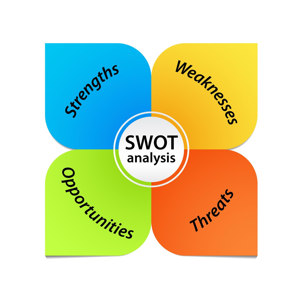SWOT Analysis –acronym stands for Strengths, Weaknesses, Opportunities, Threats. It’s a great tool to use in a group – either in a facilitated session or as a brainstorm .This method is very helpful for identifying risks within the greater organization context.
Strengths and weaknesses are generally related to issues that are internal to the organization. Strengths examine what your organization does well or its assets, skill, core competencies. Weaknesses are areas the organization could improve upon that is lacking or missing from the organization.
Typically negative risks are associated with the organization’s weaknesses and positive risks are associated with its strengths. In terms of Risk Management, we call negative Risks as Threats and Positive Risks as Opportunities.
Opportunities and threats are usually external to the organization.
SWOT analysis is sometimes known as internal-external analysis and can be used in combination with brainstorming techniques to help discover and document potential risks.
Features of this technique:
SWOT analysis identifies any opportunities for the project that arise from organizational strengths, and any threats arising from organizational weaknesses.
The technique is particularly useful for identifying internally-generated risks arising from within the organization. It is concerned more with the organization than the project itself.
The technique is commonly used in strategic decision making. It is normally used to present project information to management. The SWOT analysis is sometimes used to encourage management to alter some environmental factors from the strengths and weaknesses sections that will directly influence the project.
Steps in Applying the Technique:
- Step 1: Identify the SWOT analysis resource(s). It is important to work with individuals who understand the culture in which the project will function since they will have a better sense of the strengths and weaknesses portions of the analysis.
- Step 2 : Identify and list Organizational Strengths and Weaknesses using brainstorming.These are INTERNAL – things for which you have control over.
- Step 3: Derive Opportunities associated with the project and Threats that could harm the project. These are EXTERNAL – outside of business direct ability to control.
From the above grid, we can identify Risks in project context both in terms of Opportunities and Threats.
For example opportunities might be found by leveraging organizational strengths, or threats might arise as a result of organizational weaknesses.
In this case, Opportunities can be as under:
- Due to experienced top management, quick hiring capabilities and a good pay structure , new project can be taken up in short notice, the organization can do it because they have the capability to hire people quickly.
- Loyal clients and being market leader will help Develop export market. Acquire exclusive distribution rights.
- Discovery of a customer need that an organization can satisfy with a new product.
- Knowledgeable Research staff means more Research and Development projects can be undertaken.
Threats can be as under:
- Since the organization follows a heavy workload working culture along with low bench strength. So, the threats here are “Attrition possibilities” which is very common in high-pressure working culture environments. If attrition happens in a high scale, the organization may have to increase their pay packages in order to attract lateral hires at a faster rate.
- Low bench strength means there is no back-up if someone resigns and may need to compensate on higher pay to lateral hires to urge them to join sooner.
- More stricter clauses in Contract to offset new regulations for proactively managing projects .
- Highly reliant on one staff member – Risk associated with this can be minimized by hiring consultants in advance.
Benefits :
1) Ensures equal focus on both threats and opportunities
2 ) Offers a structured approach to identify threats and opportunities
3) Focus on internal (organizational strengths and weaknesses) and external (opportunities and threats)
4) SWOT helps quickly analyse current state of the organization.
5) Surface real problem to share.
6) Helps to develop business requirements
Issues :
1) Focuses on internally generated risks arising from organizational strengths and weaknesses.
2) Tends to produce high-level generic risks, not project-specific.
3) SWOT analysis is a very high level view; detailed analysis is almost always needed.
4) Level of Accuracy for SWOT analysis will be low because tool is highly subjective and relies on perception of resources that generated it.
Critical Success Factors (CSF ) for Effective Application:
1) Good facilitation
2) Strict adherence to the technique, to avoid confusing the four SWOT perspectives (i.e. between Strengths and Opportunities, or between Weaknesses and Threats)
To summarize, SWOT analysis has limited utility due to its high level nature. But because of its general acceptance in business community, it is helpful in drawing management attention into Risk discussion.


